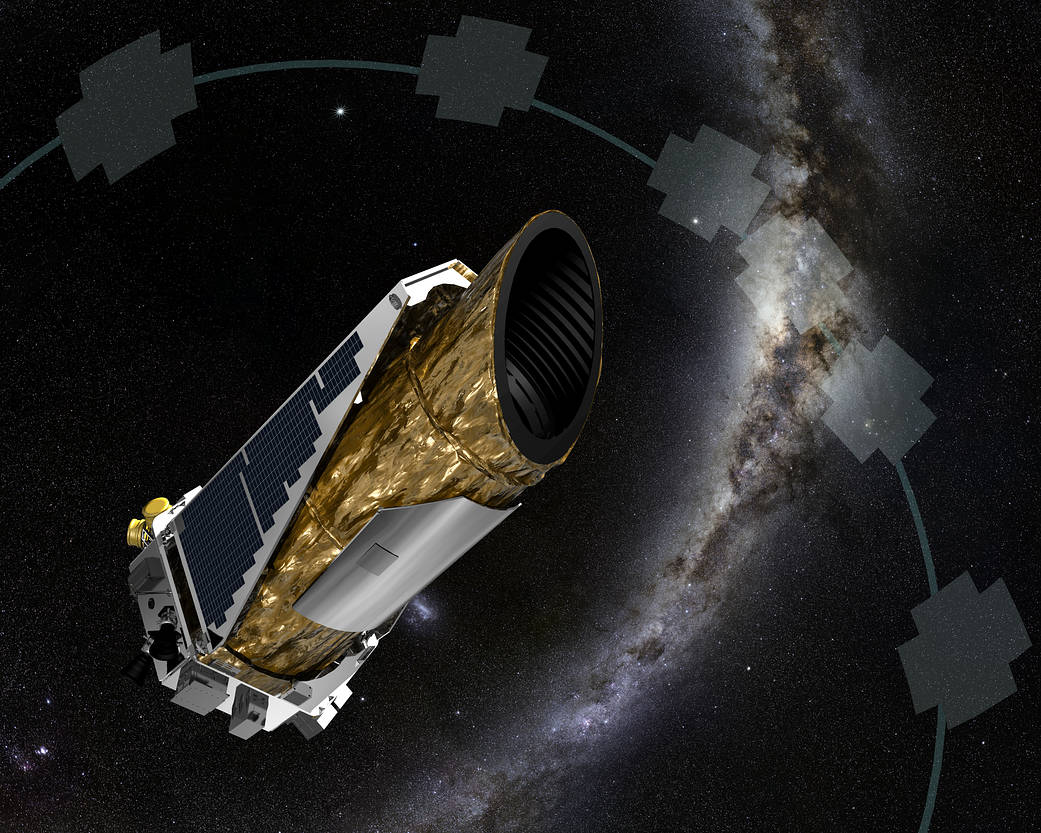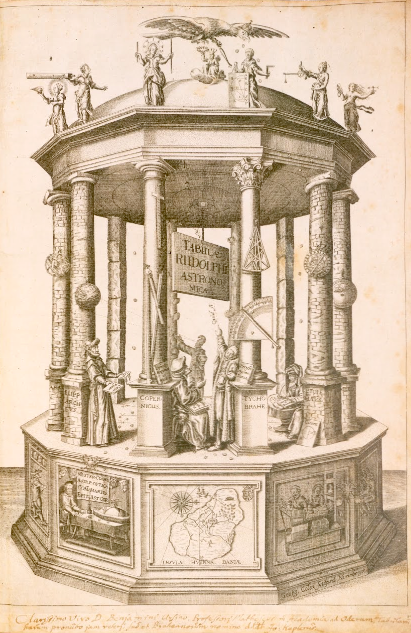Meet Scientists From The Kepler Space Telescope Mission

Header Image: Artist Concept of the Kepler Space Telescope operating during a new mission to find planets. Credit: NASA Ames/JPL-Caltech/T Pyle
2021 marks the 450th anniversary of the birthday of one of the most noted astronomers in history, Johannes Kepler. Kepler was a German astronomer who started his career as a mathematics teacher before working for another titan of astronomy, Tycho Brahe. Kepler would become the imperial mathematician to three different Holy Roman Emperors, all while becoming noted for his work in studying the laws of planetary motion. He also laid the foundation for modern optics with his studies on human vision and the behavior of light passing through lenses, and introduced an improved version of the refracting telescope. He achieved quite hefty accomplishments and notoriety within his 58 years of life!
As the scientific world celebrates the 450 years of innovation that came from Kepler and his legacy, the Adler Planetarium created a virtual Google Arts and Culture exhibition that takes a deep dive into one of Kepler’s most famous books, the Tabulae Rudolphinae, which was published in 1627. The frontispiece, or illustration facing the cover page, of this book was designed as a visual code by Kepler as a way to insert himself into the history of astronomy and assert his own place within the field! In this exhibit you can learn more about Kepler and his work as we help decipher the Kepler code!

One thing that doesn’t need deciphering is the legacy Kepler left behind. Not only is Kepler still considered one of the most influential founders of modern astronomy, but his name continues to be used today in association with astronomy and space exploration. On March 7, 2009 the Kepler space telescope was launched into Earth-trailing heliocentric orbit. The Kepler mission’s objective was to discover Earth-sized planets orbiting other stars within our region of the Milky Way. The mission lasted for over nine years, finally retiring the space telescope on November 15, 2018; the 388th anniversary of Kepler’s death.
During the nine years of the Kepler mission, an incredible array of scientists worked in various fields and research areas, extending the legacy of Kepler’s work into a more diverse modern age. As we celebrate the 450th birthday of Kepler this year, the Adler Planetarium also celebrates the Kepler mission and all the amazing scientists who continue to contribute to our understanding of the universe.
Let’s meet the scientists! Adler Planetarium Astronomer Dr. Lucianne Walkowicz was a postdoctoral fellow and dubbed the ‘Kepler Fellow for the Study of Planet-Bearing Stars’ during the Kepler mission. Dr. Savita Mathur was an analyst of the Kepler data used to characterize stars like the Sun, and was also in charge of the Kepler stellar properties catalog. Finally, Dr. Sarah Ballard was a doctoral research student during Kepler mission who published on planet discoveries.
Memorable Moments From The Mission
When a mission runs for nine years, there are bound to be a wide array of memorable moments. Dr. Lucianne Walkowicz discusses how the mission kicked off with a bang from the very start. They state, “It’s hard to beat the launch itself! Seeing a rocket launch is amazing to begin with, but it’s also incredibly nerve wracking when your whole job/career depends on something that is literally about to ride an explosion into space. It’s an amazing moment for team camaraderie too—at launch even the most dignified, accomplished senior astronomers are like little kids on Christmas morning. I met so many people at the launch who are still my friends and colleagues today!”
The nerves and overwhelming feelings of working on a NASA mission don’t end when the rocket successfully launches though. Dr. Savita Mather said that the sheer amount of data and the change in subject matter proved to be overwhelming, but still exciting. She states, “Before working on Kepler data, I was working on the seismic analysis of the Sun and a handful of solar-like stars observed by the ESA mission CoRoT, a predecessor to the Kepler mission. Once we received the first data from Kepler, we had several hundreds of stars to analyze every 3 months and I was detecting solar-like oscillations for many of them. That was such a change compared to CoRoT. While being slightly overwhelmed, it was impressive and a very exciting time!”
For the scientists involved in the Kepler mission it was this mix of innovation and discovery that made all the stress and work worthwhile. Dr. Sarah Ballard still associates certain songs with moments when she received news on the mission! “In the middle of the investigation for the first planet discovery paper I led in 2011, I went to a Fleet Foxes concert at a big venue in downtown Boston. It was such a formative professional time for me. I was checking my emails for updates from the Kepler collaboration during the concert, and the emails seemed to indicate more and more that the signal in the data was indeed due to a planet. I now associate that planet with the album “Helplessness Blues”, and I think those wires are now forever crossed in my mind.”
Exoplanet Research Fascination
Being a part of a NASA mission, especially one as groundbreaking as the Kepler mission, is an incredible experience. Even more incredible is the diversity in skills and backgrounds that the various scientists brought to the mission. Especially with astronomy, the sky is truly the limit on all the various aspects of potential research, so we asked the three scientists how they narrowed down their specific areas of interest!
For some, it all starts with being exposed to scientific research at a young age. Dr. Lucianne Walkowicz states, “I had the good fortune to be exposed to science research very early, through a summer program for high school students run by the New York Academy of Sciences in New York City (where I’m from). I liked a lot of different sciences, particularly physics and chemistry, and I ended up in astronomy because it’s a science that combines a lot of aspects of other sciences in it. When I was in college, I made it a point to try out a lot of different kinds of research (mostly by looking up astronomers who were doing cool things and just cold emailing them, asking for a job). I eventually started studying stars and their magnetism, and felt like it was really exciting to me, so I focused on that!”
For others, like Dr. Sarah Ballard, it can be attributed to being in the “right place at the right time.” Dr. Ballard said, “I came into my PhD program thinking I wanted to do observational studies of galaxies. A professor who ended up being my PhD advisor pitched me a project about exoplanets, and it sounded so interesting, that I chose that project over other directions I might have gone. In that sense, one single exciting conversation at a very important juncture shaped my trajectory toward exoplanets.”
And still others, like Dr. Savita Mathur, attribute a pivot in fields, inspired by a hobby for their current trajectories. “I obtained my engineering degree in telecommunications when I decided to move to astronomy. This led me to do my PhD on the Sun and helioseismology. I found it fascinating as the Sun is our closest star and being able to probe the deep layers of the Sun using acoustic waves was amazing to me. This also had a link with one of my hobbies, which is playing the violin. Studying sound waves in a star felt perfect to me. Then with the launch of Kepler, having hundreds of thousands of stars to study to do asteroseismology was the logical next step to put the Sun in context and also contribute to the search of exoplanets.”
Sometimes you fall into a specific research topic by luck, sometimes it is sparked by an interest or hobby from one’s own life, and sometimes it is grown over years of exploration and experience. The exciting part is that because there are so many diverse areas of research, there is room for everyone to find a topic that interests them, as well as a need for all these different research threads to develop and grow! Learn more about exoplanets in this episode of Adler Astronomy Live.
What Are They Doing Now?
Following the Kepler mission, Drs. Sarah Ballard, Savita Mathur, and Lucianne Walkowicz have all kept busy in the astronomy and science communication fields! Dr. Lucianne Walkowicz is currently an Astronomer at the Adler Planetarium. Dr. Savita Mathur is currently a Research Scientist (Ramon y Cajal) at Instituto de Astrofísica de Canarias (IAC). Dr. Sarah Ballard is currently an Assistant Professor of Astronomy at the University of Florida.
For Dr. Savita Mathur there is still plenty of excitement and pride in the research still unraveling from the Kepler mission. Dr. Mathur says, “Even though the new NASA mission TESS launched three years ago and Kepler stopped 7 years ago, I am proud and excited to keep working on the Kepler data that still represents a goldmine with the best photometric data for asteroseismology (excellent quality and longest observations up to 4 years). We are still unravelling several mysteries with the data and I expect it will be the case for many years to come.”
Dr. Sarah Ballard is excited to be helping the next generation of astronomers develop their own research topics as part of her work as a professor at a research university. “With PhD students I am advising them on their own theses. It’s extremely gratifying to see them grow as scientists, and to see the ways their independent personalities create a community in our group. It feels very important to me to be able to make space for a process like that to happen, and to model the types of behavior I think are really important: explaining complex ideas in ways that others can understand, making sure no one gets left behind, etc.”
Similarly, Dr. Lucianne Walkowicz has been using the COVID-19 closure of the Adler Planetarium as a way to innovate and expand science communication to entirely new audiences with their work on the Wow! Signal space comedy show. “I’m really proud of Wow! Signal, the space comedy YouTube show my team at the Adler created during quarantine. It’s a fun, silly way of sparking people’s curiosity about science, and it’s really different from a lot of other programming that’s out there. More than anything, it’s a testament to the wonderfully creative folks I get to work with!”
It is this push to continue, not only unraveling the mysteries of the universe and the research collected during the Kepler mission, but also inspiring new generations of researchers and interested members of the public alike, that may be the enduring legacy of both the Kepler mission and Johannes Kepler himself. Today there is more scientific data than ever before, and the push for open source and open data initiatives is allowing more people than ever to have access to the data, the research, but also the space to do the work. As Dr. Sarah Ballard states, “I like the idea of a decentralized academic ecosystem, where knowledge flows from all types of academic institutions, rather than only the historically “elite” universities.”
450 years after the birth of Johannes Kepler the Adler Planetarium is excited to continue the legacy of space exploration and discovery, and we cannot wait to see how scientists continue to innovate and expand not only our knowledge of the space we occupy but also who is able to participate in this amazing research.
The Adler Planetarium thanks Dr. Sarah Ballard, Dr. Savita Mathur, and Dr. Lucianne Walkowicz for their participation and assistance in the creation of this blog.






